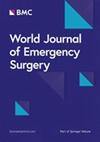急诊剖腹手术后虚弱状态和出院目的地的变化
IF 5.8
1区 医学
Q1 EMERGENCY MEDICINE
引用次数: 0
摘要
术前虚弱对急诊剖腹手术(EmLap)后的发病率和死亡率有不利影响,尤其是在老年人(65岁及以上)中。人们对EmLap之后的虚弱知之甚少。我们探讨了emlap前后患者虚弱状态的变化及其对出院目的地的影响。从2022年5月至2023年4月招募年龄≥65岁的急性手术部位EmLap患者。前瞻性数据收集包括人口统计、虚弱、死亡率和出院目的地。在emlap前和emlap后第90天使用Rockwood临床虚弱量表评估虚弱程度(4分虚弱)。没有90天随访的EmLap患者被排除在外。p值< 0.05被认为是显著的。63例EmLap患者纳入研究。年龄中位数为75岁(65 ~ 91岁),女性36例(57.1%)。11例(17.5%)患者在emlap治疗前存在虚弱,10例(15.9%)患者在emlap治疗后第90天出现新的虚弱。在实施emlap之前,所有患者都来自家中,20.6%的体弱和体弱前期患者有一揽子护理服务(POC)。在emlap后90天,1名患者仍然是住院患者,但25.8%的患者出院目的地发生了变化:养老院(n = 1),新POC的家庭(n = 2)和POC增加的家庭(n = 13)。在16例改变出院目的地的患者中,9例(56.3%)为emlap前虚弱患者。emlap前的虚弱与出院时家庭环境的改变有显著的相关性(p < 0.00001)。急诊手术可以增加病人的虚弱状态,并显著增加出院后的护理需求和社会支持。所有EmLap患者入院前和入院后需要进行虚弱评估,以改善EmLap后的护理计划和患者期望。本文章由计算机程序翻译,如有差异,请以英文原文为准。
Changes in frailty status and discharge destination post emergency laparotomy
Pre-operative frailty adversely affects morbidity and mortality after emergency laparotomy (EmLap), especially in older adults (65 years and above). Little is known about frailty after EmLap. We explored the change in frailty status from pre- to post-EmLap and any influence on discharge destination. EmLap patients aged ≥ 65years from an acute surgical site were recruited from May 2022 to April 2023. Prospective data collection included demographics, frailty, mortality and discharge destination. Frailty was assessed using the Rockwood Clinical Frailty Scale at pre-EmLap and day-90 post-EmLap (< 4 as non-frail, 4 as pre-frail and > 4 as frail). EmLap patients with no 90-day follow-up were excluded. A p-value of < 0.05 was considered significant. 63 EmLap patients were included in the study. The median age was 75 years (range 65–91 years) with 36 (57.1%) females. Eleven (17.5%) were living with frailty pre-EmLap, and 10 (15.9%) developed new frailty by day-90 post-EmLap. Pre-EmLap, all patients came from home with 20.6% of the frail and pre-frail group having a package of care service (POC) in place. On 90-day post-EmLap, 1 was still an inpatient but 25.8% had a change in discharge destination: care home (n = 1), home with new POC (n = 2) and home with increased POC (n = 13). Of the 16 patients with change of discharge destination, 9 (56.3%) were frail pre-EmLap. There was a significant association between pre-EmLap frailty and change in home circumstances on discharge (p < 0.00001). Emergency surgery can increase a patient’s frailty status and significantly increases care requirements and social support after hospital discharge. Frailty assessment needs to be performed before and after admission in all EmLap patients to improve post-EmLap care planning and patient expectations.
求助全文
通过发布文献求助,成功后即可免费获取论文全文。
去求助
来源期刊

World Journal of Emergency Surgery
EMERGENCY MEDICINE-SURGERY
CiteScore
14.50
自引率
5.00%
发文量
60
审稿时长
10 weeks
期刊介绍:
The World Journal of Emergency Surgery is an open access, peer-reviewed journal covering all facets of clinical and basic research in traumatic and non-traumatic emergency surgery and related fields. Topics include emergency surgery, acute care surgery, trauma surgery, intensive care, trauma management, and resuscitation, among others.
 求助内容:
求助内容: 应助结果提醒方式:
应助结果提醒方式:


